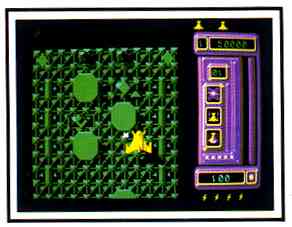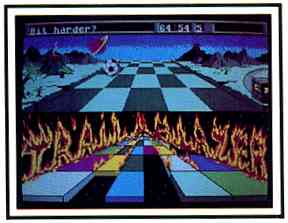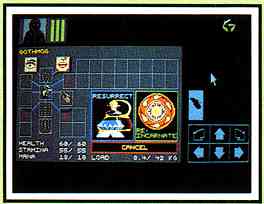Goldrunner, Jupiter Probe and Trailblazer
by David Plotkin
It's true that computer games don't have to have graphics or sound; playability is certainly the single most important factor for a good game But for this special issue of START it's exciting to examine the excellent graphics and sound capabilities of the ST, and how this state-of-the-art equipment, combined with gifted and creative programming teams, can make computer games more exciting and keep the player's interest longer.
GOLDRUNNER
Microdeal's Goldrunner is a superbly-crafted shoot-'em-up and a real
joystick buster My hands are still shaking from my last round! In Goldrunner,
you pilot a spacecraft across a smoothly scrolling landscape. Control is
either joystick, mouse or keyboard; I recommend the joystick. The object
is to destroy everything you can, and you have the firepower to do it.
The primary targets are ground-based buildings, but some lightning-fast
enemy craft will come up to do battle. You can run over these without damage,
but they launch missiles at you; take five hits and you lose one of your
lives.

Goldrunner
The documentation claims that the game is split up into "rings," with each ring being a different world you must attack. Destroy enough buildings and machinery and the ring is depleted of its energy. Then a door opens in one of the destroyed buildings, and you move on to a bonus round, where you shoot down formations of enemy fighters which don't shoot back to build up your point total. Then you move on to the next ring. You can tell when a ring has been depleted when one of three icons to the right of the screen turns black. The other icons represent the state of your lasers and auxiliary boosters, which can give you an extra boost of speed.
Goldrunner sports just about the best graphics I've seen in a space game. Your highly-detailed spacecraft rolls into turns convincingly. The landscape is realistic, with shaded buildings, shadows and other shapes. The enemy craft which rise to do battle are well rendered, and explode convincingly, leaving gaping holes. The digitized sound is superb, with voiced commands and explosions. The scrolling is smooth at even very high speeds.
This is one tough game! Every time you die, you end up back at the beginning of the current ring. All the buildings you've destroyed are reincarnated, so you must begin depleting the ring energy all over again. This proves frustrating. An added difficulty is that some of the buildings will destroy you if you run into them. They look like regular buildings, except that they cast a longer shadow (to indicate that they are taller) and cannot be destroyed by gunfire. It is next to impossible in the heat of battle to keep an eye on the length of the shadows of the buildings, and this is the most common way to lose your spacecraft. The trick is to memorize the playing field and fly carefully to avoid those buildings. One consequence of this is that this game is addicting, since you can pinpoint your error; the urge to try again to do better can bring cramps to your joystick hand.
In Goldrunner,
the object is to
destroy everything
you can.
The only complaints I have are with the packaging of this game. The
copy protection scheme means that you must autoboot the disk, and I found
that the computer froze up often when writing the high scores to disk.
Further, the instructions could benefit from a screen illustration to show
which icons do what, and also what a gate (between rings) looks like. I
passed it up several times and only found it after some coaching from MichTron.
It is, by the way, the large upside down "U" with a big shadow in the center
portion.
| The Shape of Dungeons To Come
I've never been too impressed by the graphics accompanying the many "dungeon" games available. However, the upcoming Dungeonmaster from FTL Games should change all this. This dungeon construction set allows you to plan and then explore your own dungeons. Fully mouse-driven, it's easy to use, and the graphics are gorgeous. The extremely detailed dungeon walls show every crack, even to blood-spotted stones and growing moss. Precise pictures of heroes hang from the walls, as do signs pointing the way to other portions of the dungeon. Accoutrements for holding prisoners are bolted to the dripping stone walls. Characters can be viewed in a detail screen, where their strength, health and the items they are carrying are shown. You can transfer items between the members of your party by use of the mouse, and all the items are shown in great detail. Massive iron gates and doorways are also well represented. The version of Dungeonmaster I looked at was far from finished, and I'm sure that many more carefully detailed objects will be available in those impressively rendered dungeons. I'm looking forward to seeing the finished product.
|
JUPITER PROBE
Jupiter Probe is like Goldrunner in so many ways-except that Goldrunner
is so much the better. In Jupiter Probe, you pilot a spacecraft across
a vertically scrolling surface of what the instructions call the planet
Jupiter. Strange that the green hills and blue water look so much like
Earth! Even the signs in the river are in English. The object is to shoot
down aliens that come down from the top of the screen. The screen only
scrolls in one direction (unlike Goldrunner), and you move your spacecraft
back and forth across the bottom portion of the screen with a joystick,
keyboard or mouse.

Jupiter Probe
The attacking aliens come in three varieties. Standard aliens explode from a single hit, while the larger "mutations" take multiple hits. Finally, there are formations. Destroy the entire formation and you can run over a star, giving you an extra weapon: either a "sonic" (destroys all aliens on the screen except mutations) or a shield. The shield protects you from everything for a short period of time.
Jupiter Probe is split into levels; losing a life causes you to start at the beginning of the current level. You get the customary three ships. Strangely, only one button activates both shields and sonics, so you must use up your shields before you can start using your sonics. Also, the indicator on the screen warning you that your shield is about to run out is a brief flashing of your ship, easy to miss in the heat of combat. And the shield lasts only a few seconds. Finally, the area of the screen which keeps track of how many sonics and shields you have left uses the same symbol for both, so you don't really know what you have.
The voice effect of the game is good (it warns you of approaching formations), but doesn't add materially to the game. The game lacks the razor-sharp graphics, dual-direction scrolling and bonus levels of Goldrunner; you end up with a rather tame, scrolling arcade shoot-em-up.
TRAILBLAZER
Imagine a world where you guide an animated soccer ball (with a face,
no less) down a checkerboard road. You control the ball's speed and direction,
and can make it hop into the air by pressing the fire button. The road
is littered with hazards: squares which speed you up, slow you down, reverse
your controls, make you hop, reverse your direction and swallow you up!
This is the world of Trailblazer.
Trailblazer begins by letting you choose from three scenarios: one-player arcade, two-player arcade and a three-course test. Once you choose, you move your pointer to a window where you set the names of the three courses you want to use from the ten courses available. You use these courses only if you chose the three-course test; contrary to the directions, if you chose the arcade options then you always start with course one and proceed to the higher ones. The three-course test lets you run each course in the order you selected. Your points rack up depending on how fast you complete each course. In the arcade option, you must finish each course in the allocated time to proceed to the next course. If you fail to do so, the game is over.

Trailblazer
You steer the soccer ball with your joystick. Each of the different squares that comprise the road is a different color It quickly becomes apparent that memorizing the courses and planning your strategy count more than speed.
In Trailblazer,
you guide a soccer
ball (with a face!)
down a checkerboard
road.
You get only five "hops" per course, so you must hop over as many of the black swallowing holes as you can by using the advantageously-placed white squares which flip you into the air, so you don't have to use one of your precious hops. Even the "easiest" of the ten courses is diabolically difficult. Upper levels are even trickier. One of the nastiest courses features purple reversing blocks on the far side of a long stretch of green "slow down" blocks. If you're unlucky enough to run into a purple block, you must move backwards slowly, watching your time run out.
Trailblazer boasts smooth and colorful graphics, as well as options such as the ability to bounce further, reduce inertia and select a hilly or flat course. High scores get saved to disk but there is no pause feature.
In addition to the ten courses on the disk, there is a course editor, so you can build your own. Although this editor works. it is clumsy and difficult to use, especially on a machine capable of using a mouse and menus. The commands for selecting and placing different colored blocks in your course use the keyboard. For example, to change a block's color, you use the 2 and 8 keys. You press the "\" key to move the newly created block from the scratch pad to the course itself. There's just too much keyboard input. Also, you cannot test your creation from the editor. You must exit and rerun Trailblazer.
Since exiting the editor and switching to Trailblazer requires rebooting, the testing process gets tedious. I hope to see an improved editor someday, because building your own courses can be a lot of fun and a real challenge.
Trailblazer is a game of concentration that will tax your memory but since it also includes arcade elements, it should have a wide appeal. With a better editor, it would be even more valuable.
If you'd like more articles like this, circle 170 on the Reader Service Card.
David Plotkin is a chemical engineer with Chevron, USA and a long-time contributor to Antic and START. He also writes software documentation.
PRODUCTS MENTIONED
-
Goldrunner, $39.95. Microdeal, distributed by MichTron, 576 South
Telegraph, Pontiac, Ml 48053. (313)334-5700.
CIRCLE 172 ON READER SERVICE CARD -
Jupiter Probe, $24.95. Microdeal. distributed by MichTron, 576 South
Telegraph, Pontiac, MI 48053. (313)334-5700.
CIRCLE 173 ON READER SERVICE CARD -
Trailblazer, $49.95. Mindscape, Inc., 3444 Dundee Road, Northbrook,
IL 60062. (312) 480-7667.
CIRCLE 174 ON READER SERVICE CARD
